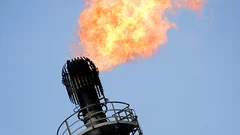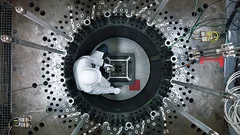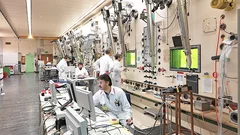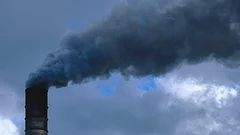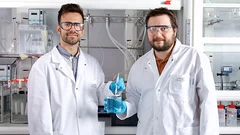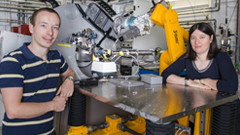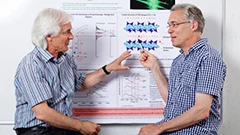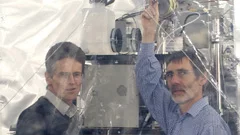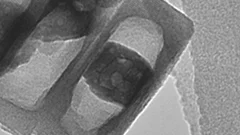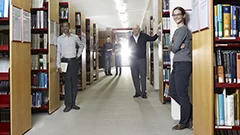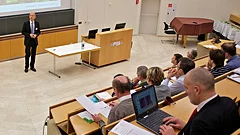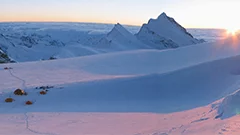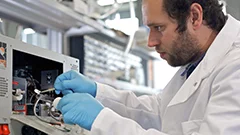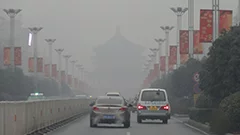Energy and Climate
The energy research performed at PSI focuses on processes that can be used in sustainable and safer technologies, ideally with minimal CO2 emissions. The main emphasis is on renewable energy sources. The ESI (Energy System Integration) platform enables research and industry to test solutions for integrating renewables into the existing energy supply. Another focus in this area is the safer use of nuclear energy. These activities are supplemented by analyses giving a comprehensive assessment of energy systems. PSI scientists in the Energy and Environment division study the chemical processes that take place in the atmosphere.
Find out more at: Overview Energy and Climate
Using methane rather than flaring it
Chemists at ETH Zurich and the Paul Scherrer Institute have found a new, direct way to convert gaseous methane into liquid methanol. This offers industry the interesting prospect of using the gas, rather than simply burning it off, as is currently the case.
Decommissioning of the research reactor Proteus
Start of the public examination period for decommissioning of the nuclear facility Proteus at the Paul Scherrer Institute PSIThe nuclear research facility Proteus is a so-called zero-power reactor. In service, the thermal output of the reactor was limited to a maximum of 1 kW. That means this is an experimental reactor that was run at a power level so low that it did not require cooling. Proteus went into service in 1968. The PSI would like to decommission the facility. The decommissioning project is now being publicly announced in the legally prescribed, official publications.
The hotlab research facility
Start of the public examination period for renewed authorization to operate the research facility hotlab at the Paul Scherrer Institute PSIThe hotlab at the Paul Scherrer Institute PSI is a facility, unique in Switzerland, where researchers study highly radioactive materials in specially shielded chambers called hot cells. It serves the needs of applied materials research on highly radioactive samples from core structural components and fuel rods from nuclear power plants, research reactors, and the PSI radiation facilities. Through its operation of the hotlab, the Paul Scherrer Institute also contributes to the safety of the nuclear power plants in Switzerland. Around thirty staff members attend to the hotlab's safety technology and analysis infrastructure.
Kohlendioxid: Das Klimaproblem im Untergrund entsorgen?
Allen Warnungen vor den Folgen des Klimawandels zum Trotz und unbeeindruckt von politischen Absichtserklärungen: Die weltweiten Kohlendioxidemissionen steigen und steigen. Hauptverantwortlich dafür sind Kohle- und Gaskraftwerke, die den zunehmenden Strombedarf decken. Könnte man deren Kohlendioxidemissionen dauerhaft im Boden speichern, anstatt damit Atmosphäre und Klima zu belasten? Und wäre das auch für die Schweiz interessant? Diese Fragen beleuchtet der neueste Energie-Spiegel des PSI.This news release is only available in German.
More robust thanks to imperfections
Microscopic deviations from the ideal structure render uranium dioxide, the fuel commonly used in nuclear power plants, more resistant to radiation damage.
Water pathways make fuel cells more efficient
Researchers from the Paul Scherrer Institute (PSI) have developed a coating technique in the laboratory conditions that could raise the efficiency of fuel cells. The PSI scientists have already applied to patent the technique, which is suitable for mass production.
The key to charging a lithium-ion battery rapidly
Lithium iron phosphate batteries are very durable and can be charged relatively quickly. Researchers from the Paul Scherrer Institute (PSI), ETH Zurich and Japanese car manufacturer Toyota reveal the reasons for these properties in a new study. The findings were made possible thanks to measurements using a new method at the Swiss Light Source (SLS) at PSI.
Radioactive waste caught in a cement trap
In a deep geological repository, low and intermediate level radioactive waste from nuclear applications is solidified by cementitious materials for several thousand years. Researchers from the Paul Scherrer Institute and the Karlsruhe Institute of Technology have now demonstrated how cement limits the mobility of those radioactive substances. The new findings improve our understanding of the processes involved in this early phase of deep geological disposal.
Particulate matter from modern gasoline engines damages our lungs
For years, studies have proved that fine dust from petrol engines can damage our health. Modern engine technology does not help, either, as researchers from the University of Bern and the Paul Scherrer Institute (PSI) reveal.
Gasoline from a nanoreactor
Researchers from the Paul Scherrer Institute (PSI) and ETH Zurich have developed a miniscule chemical reactor in the lab that could one day be used to produce gasoline and diesel more sustainably and cost-effectively than today. By specifically modifying nanometre-sized, porous zeolite crystals, the scientists built a nanoreactor that is able to complete two of the conversion steps for the production of hydrocarbons.
PSI expertise boosts research for the energy transition
Researchers from the Paul Scherrer Institute (PSI) are involved in several projects under the new National Research Programme Energy Turnaround (NRP70) of the Swiss National Science Foundation (SNSF). The PSI experts tackle issues such as particle emissions from wood heating systems, the holistic evaluation of energy systems and the production of semiconductor components for novel transformers.
Keeping geothermal energy on the table
A study by the Centre for Technology Assessment TA-Swiss, coordinated by the Paul Scherrer Institute, recommends further pursuing deep geothermal energy in Switzerland. The energy resources underground are vast, environmentally friendly to extract and available around the clock, the authors conclude. The earthquake risk and the cost of electricity production, which are still too high, however, remain challenges that society needs to weigh up against the advantages of deep geothermal energy.
Biomasse als Stütze der Energiewende
Mit 80 Teilnehmerinnen und Teilnehmern fand am 2. Dezember am Paul Scherrer Institut PSI die erste Jahreskonferenz des Kompetenzzentrums des Bundes für Bioenergie (SCCER BIOSWEET) statt. Das im Rahmen des Aktionsplans Energieforschung Schweiz gegründete Kompetenzzentrum definierte in der Tagung die Ziele, Strategien und Positionierung der Bioenergie-Forschung vor dem Hintergrund der neuen schweizerischen Energiepolitik.This news release is only available in German.
Das Kompetenzzentrum Speicherung zieht nach einem Jahr Bilanz
Am vergangenen 4. November fand am Paul Scherrer Institut das erste Jahressymposium des Kompetenzzentrum des Bundes für Forschung zu Strom- und Wärmespeicherung (SCCER Heat and Electricity Storage) statt. Vertreter aus den beteiligten Forschungsgruppen sowie aus Industrieunternehmen mit einem Bezug zum Thema Speicherung berichteten in ihren Vorträgen über die jüngsten Fortschritte auf dem Gebiet der Wärme- und Stromspeicherung in der Schweiz. Die Tagung zeigte die Intensität der Transformationen, die von der Energiestrategie 2050 in Gang gesetzt worden sind.This news release is only available in German.
When thawing glaciers release pollutants
As glaciers increasingly melt in the wake of climate change, it is not only the landscape that is affected. Thawing glaciers also release many industrial pollutants stored in the ice into the environment. Now, within the scope of a Swiss National Science Foundation project, researchers from the Paul Scherrer Institute (PSI), Empa, ETH Zurich and the University of Berne have measured the concentrations of a class of these pollutants à polychlorinated biphenyls (PCB) à in the ice of an Alpine glacier accurately for the first time.
During winter smog fire places put cars in the shade
On winter smog days in Switzerland wood burning is the main source of harmful carbon-containing fine particles. This is revealed by a large-scale Swiss study on fine particle pollution conducted over a five-year period by scientists at the Paul Scherrer Institute (PSI), the University of Bern and ETH Zurich.
New Renewables on integration course
The Swiss government’s Energy Strategy 2050 includes a significant expansion of renewable energy such as solar and wind power. The integration of this electric energy, which is produced in a decentralised way and with temporal fluctuations, poses a major challenge for power grids. One possible solution involves using the electricity surplus that would otherwise overload the grid for the production of gases such as hydrogen or methane. The electric energy would thus be stored temporarily in form of chemical energy. These gaseous energy carriers can be converted back into electricity, heat or kinetic energy (in gas engines) at a later date as and when needed. Dubbed power to gas, the concept is the focus of the new Energy System Integration (ESI) Platform at PSI.
Airpocalypse explained
The causes of China's record level fine particulate pollution in winter 2013 At the beginning of 2013 a greyish-brown blanket of smog lay over large areas of China for several months. The fine particle pollution was higher by 1 to 2 orders of magnitude than the levels normally measured in Western Europe and the United States. An international team of researchers under the lead of the Paul Scherrer Institute PSI and the Institute of Earth Environment, Chinese Academy of the Sciences revealed the causes of the airpocalypse. The study published in the journal Nature also describes what steps are to be taken to prevent an environmental crisis of this kind in the future.
Energiewende in Reinkultur – in Wädenswil zu bestaunen
Der am Paul Scherrer Institut PSI entwickelte Prozess der hydrothermalen Methanierung von wässriger Biomasse erreicht einen wichtigen Meilenstein: Dank der Zusammenarbeit im neuen Kompetenzzentrum des Bundes für Bioenergie BIOSWEET konnten Forschende des PSI, der ZHAW, der ETH Lausanne, der Empa und der Hochschule für Technik Rapperswil die technische Machbarkeit der Methanherstellung aus Mikroalgen demonstrieren. Der dazu verwendete Algenbioreaktor sowie die Anlage zur Methanierung der Algen können am 24. September auf dem Campus Grüental der ZHAW in Wädenswil besichtigt werden. Für Medienschaffende gibt es von 14:00 bis 14:30 eine spezielle Führung.This news release is only available in German.
What attacks on oil pipelines have in common with epidemics
How susceptible is the global energy infrastructure to attacks by non-state actors? Has the number of attacks on this infrastructure actually increased of late? Which regions of the world are especially vulnerable? And which tactics do the attackers use? Scientists are looking to find the answers to these and other related questions with the aid of a database developed by researchers from the Center of Security Studies at ETH Zurich in collaboration with the Paul Scherrer Institute PSI.
